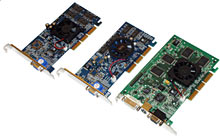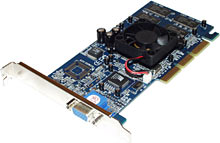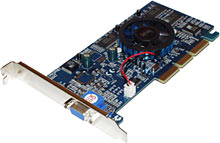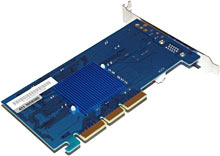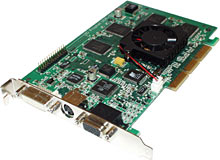
Hercules budget graphics cards: 3D Prophet II MX400, 3D Prophet 4000XT and 3D Prophet DDR-DVI
Review date: 20 June 2001.Last modified 03-Dec-2011.
It Is Written that the way to get decent performance out of your PC, without spending a fortune, is to buy slightly old technology. Not something that was new five years ago; by now, that'll be a paperweight. More like something that was new one or two years ago.
Around that age bracket, you'll find gear that costs much less than it did when it was new, and a similar amount less than the bleeding edge hardware of the moment. But which still isn't hopelessly off the pace.
In bang-per-buck terms, one to two year old technology is pretty much invariably much better value than shiny new equipment. Pay, say, a quarter as much; get half as much speed.
If you're shopping for game-playing hardware, like 3D-capable video cards, this is an especially sensible strategy. The latest new and exciting video card can be counted on to beat older gear, sure. But you can also count on its thrilling new features not being fully used by current software.
Nobody develops games for brand new hardware, as a general rule. That's partly because test hardware isn't available to the developers long enough before the gear hits the streets, and partly because there just aren't enough people who buy a new video card whenever they possibly can. The market isn't big enough. Create a game that doesn't run well unless you've got the latest hardware - which would be a 1.4GHz Athlon machine with a GeForce3 graphics card, at the time of writing - and you annoy all of the people that don't have a Tiny God on their desk.
There's another reason to buy older hardware. You can get more mature drivers for it than come on the CD in the box. Brand new video cards, in particular, often have driver peculiarities. But if you can just venture forth to the card or chipset manufacturer's Web site and download drivers a year newer than the ones that come in the box, you generally needn't worry. Get the new drivers before you upgrade to the new video card and you don't need to even look at the stock ones.
So here are three options for your consideration, in the less-than-totally-new video card department. They're all under the Hercules brand, but two of them - the 3D Prophet DDR-DVI and 3D Prophet II MX400 - use Nvidia chipsets that have been used by umpteen other manufacturers as well. The third one, the 3D Prophet 4000XT, uses the STMicroelectronics Kyro chipset. They range in price from $AU121 to $AU313.50, delivered. That's about a fifth to a third of the current local price of a GeForce3 card.
So which one's best, and why?
On with the show!
3D Prophet II MX400
The 3D Prophet II MX400 is a plain vanilla 32Mb GeForce2 MX 400 video card which costs $AU247.50, delivered.
You don't get any fancy extras with the Prophet II MX400; inside the flashy box is just the card, a paper manual, and one CD. The CD's got a couple of game demos on it as well as some slightly crusty old drivers, but the whole disc's still worth approximately nothing.
There's nothing wrong with that, mind you. I like simple bundles like this. They don't make you pay for superannuated games you don't necessarily want to play, DVD playback software you're not going to use, colour correction software that's of no use at all to most people, and similar pointless frills. Personally, I'd rather this card were a basic Original Equipment Manufacturer (OEM) unit, with a white box and no paper manual, if that meant it cost $10 less. But what are you gonna do.
The important question for buyers of a straight-up-and-down video card like this - the Prophet II MX400 has one VGA output, and that's it - is how it performs.
The answer is "quite well for the money, thank you".
To work out why this GeForce2 MX card's a good one, but some currently available aren't, you need to know about the three kinds of MX chipset that exist at the moment.
Nvidia are crazy for market segmentation. They like to split their chipsets up into differently clocked versions with different RAM interfaces. Hence, the GeForce2 MX 200 and MX 400 chipsets. The Prophet II MX400 has its chipset type right there on the label.
The only real difference between the 200 and 400 flavours of MX and the original GeForce2 MX - which is still widely available - is the memory architecture.
The original GeForce2 MX can work with 64 or 128 bit Standard Data Rate (SDR) memory, or 64 bit Double Data Rate (DDR). 128 bit SDR and 64 bit DDR have the same performance for a given clock speed - because of the clock-doubling that's the whole idea of DDR technology - and so there's no real difference in performance between GeForce2 cards that use these memory flavours. But 64 bit SDR memory halves the RAM bandwidth available. To my knowledge, no manufacturer's made a plain MX board using this slower RAM.
The MX 400 can use the same memory types as the original MX, but it's got a slightly higher default core clock speed - 200MHz, versus 175MHz for the original MX. Since nobody makes MX 400 boards with 64 bit SDR RAM, as far as I know, the upshot is that any MX 400 card, at its stock core speed, will give you a little more performance than a plain MX in resolutions up to about the 1024 by 768 mark. Though probably not enough to notice. As the resolution climbs further, the 400 and the original MX level off to be practically identical.
There's really not much in it at any resolution, though. If you're choosing between an MX and an MX 400 card with the same amount of RAM, treat them as if they perform the same, because they pretty much do.
If you're into overclocking, you can run any original MX card at 200MHz core speed anyway. If the card comes with a lousy cooler on its main chip, or no cooler at all, then higher core speeds may be a problem unless you upgrade the cooler. Whether this is worthwhile for a sub-10% performance improvement is highly questionable. If the card's got a good enough cooler to handle a small core overclock, though, it's easy to get MX 400 speed out of a plain MX. The MX 400 does not have much more overclocking headroom than the plain MX; overclock 'em both and the MX will probably still win, but the margin will, once again, be small enough not to really matter.
The MX 200 is the low performance GeForce2 variant. It has the same 175MHz default clock speed as the original MX, but it only supports 64 bit SDR memory.
Memory speed is a big performance limiting factor for most graphics cards at high resolutions. Halving the memory speed means the MX 200 in 640 by 480 will be working its memory about eight-tenths as hard as an MX 400 or original MX card in 1024 by 768. It'll be about as fast as any other MX in 640 by 480, therefore; it'll start to fall away in 800 by 600, and be embarrassingly slow compared with better-equipped MXes in higher resolutions than that.
Why does anybody bother with the MX 200, then? Well, it's cheap. The narrower memory bus means MX 200 cards need fewer and/or cheaper RAM chips, and RAM chips represent a big slice of the price of all current graphics cards. So the MX 200 lets manufacturers build computers which they can describe as having "GeForce2 graphics power!", without actually having to spend much on the graphics card. Never mind the fact that that "GeForce2 power" isn't actually very powerful at any half-decent resolution; there's a tick in the right box, and that's what matters to the mass market.
If you've got a 17 inch or smaller monitor and thus can't clearly view resolutions above 1024 by 768, an MX or MX 400 card will be pretty much as good as a full GeForce2 GTS. The features the MX lacks don't have a big impact on performance, and only in higher resolutions will the DDR memory on the GTS board give it a big advantage.
So the GeForce2 MX 400 is a respectable performer, and good value for money. And the 3D Prophet II MX400 is a perfectly good MX 400 card. But there are a pile of other MX and MX 400 options, and you can get original MX cards with TV output and a couple of bundled games for a bit less than the price of the Hercules offering.
It's a close-run thing, though, and the Prophet has a groovy blue circuit board and build quality that's certainly as good as that of any of the smaller Taiwanese names. So this is a perfectly good, workmanlike product; it's just not a big winner.
3D Prophet 4000XT
Now that the STMicro Kyro II chipset's out, the plain original-Kyro 3D Prophet 4000XT has suddenly become uninteresting. It was never a red-hot sales dynamo for Hercules, but now it's really not attracting much attention.
Which isn't fair. For a start, this is a cheap card. When I first wrote this review it was $AU198 delivered, which was pretty cool, but now that I'm updating the review (in early November 2001), it's on special for $AU121 delivered. So its list price is GeForce2 MX 200 pricing, and its discounted price is a bargain in anyone's language.
The Kyro II uses a rendering system that handles RAM more efficiently than Nvidia's boards can manage, which means that the Prophet 4500 (Hercules' own Kyro 2 card, reviewed here) ends up performing pretty much like a GeForce2 GTS, and certainly better than any GeForce2 MX, almost across the board. The drivers used to be rather dodgy but they're pretty good now. For general gaming purposes, even at high resolutions, the Kyro II performs as well as, or better than, anything Nvidia can offer, on a bang-per-buck basis.
So what's the original Kyro like compared with the Kyro II?
Well, it's the same thing, only with a lower clock speed.
Really. That's the full extent of the difference.
The RAM and core in the Kyro II run at 175MHz by default; the original Kyro's 125MHz.
STMicro reworked the Kyro significantly to create the faster Kyro II, but they didn't add any features. The newer chipset has more transistors and uses less power, but it essentially just does the same stuff faster.
Both Kyro flavours thus share many qualities. Apart from their surprisingly good performance (considering their modest RAM speed), they also render everything internally in 32 bit colour. This means that their 16 bit colour mode looks unusually good, but runs unusually slowly, compared with 32 bit. You might as well run in 32 bit all the time.
Given that the Kyro runs at better than 70% of the speed of the Kyro II, it's reasonable to expect the older chipset to give you something like 70% of the Kyro II's performance.
And it does.
Not bad for half the money, eh?
Actually, it sometimes does better than that, for moderate resolutions. Run in 1024 by 768 and there'll sometimes be less than 10% between the two chipsets - although, for most 3D games, that "70% of the speed of the Kyro II" figure is pretty much the way to bet.
The Kyro more or less lines up with GeForce2 MX performance - MX 400 level, not MX 200 - in 1024 by 768, 32 bit colour. That's with no Full Screen Anti-Aliasing (FSAA), which renders extra image data and samples it down to smooth out "jaggy" edges on diagonal lines.
At lower resolutions, the GeForce2 MX wins compared with the Kyro; at higher resolutions, or when you turn on FSAA, the MX loses. The original Kyro can often deliver a playable 3D single player game - well, if your standards aren't too high, anyway - in 1600 by 1200. At that resolution, the MX is choking badly.
The difference between the Kyro and the Kyro II is noticeable, and the newer card's a better board. But the original Kyro, given its much lower price, gives the Prophet 4500 a serious run for its money.
Why is the 4500 so expensive? Because it's got twice as much memory, that's why. Hercules make versions of the 4500 with and without TV output, but they both have 64Mb of memory.
You can actually use 64Mb of video memory, a bit, in some current games. You can also just turn the texture detail down and keep on trucking with a humble 16Mb card, though. 32Mb really is still adequate for pretty much any game. Only if you're into pro 3D rendering, with gigantic preview window texture sets, is another 32Mb of RAM really likely to make a difference.
The 4000XT hasn't set the world on fire, but if you want to upgrade your PC's 3D capabilities without spending the national debt of Bolivia on a GeForce3, there's a great deal to be said for the plain old Kyro.
If you dig heat sinks, by the way, the 4000XT is for you. You get one nifty round chip cooler on the front of the board, and this washboard heat sink on the back. The original Kyro actually runs hotter than the Kyro II, so there's some justification for the extra aluminium on this card.
You can also get a PCI version of the 4000XT, which performs much the same (the bandwidth difference between PCI and AGP only really matters if you've run out of video memory, and then a faster graphics bus just lets your PC suck a bit less...), but can be installed in computers with no AGP slot. This includes old crusty computers that don't need a hot graphics card, but it also includes brand-name machines with an AGP interface for built-in video hardware and no AGP slot, and computers that already have one graphics card installed, but need another for multi-monitor applications.
The PCI 4000XT sells, as I write this at the start of November 2001, for $AU181.50 delivered from Aus PC Market. It doesn't have the AGP 4000XT's big fat discount, but reasonably fast PCI cards are hard to find, and this looks like a good one.
3D Prophet DDR-DVI
GeForce DDR video cards used to be the absolute top of the heap, in those far-off and misty days around the end of 1999. But at low to medium resolutions - up to roughly 1024 by 768, 32 bit colour - there isn't much between the plain GeForce 256 and the DDR version, with its more expensive double-speed memory.
As you wind the resolution up, though, the DDR GeForce holds its frame rate up better than the SDR one can manage.
The 3D Prophet DDR-DVI is a 32Mb GeForce DDR. So you're not paying for 64Mb of RAM, but you are still paying for DDR memory. Which explains why this card, despite having the oldest technology of the three cards in this comparison, still costs the most - $AU313.50, delivered.
How's the GeForce DDR compare with more recent video cards? Not too badly.
But not well enough to justify its price.
In 1024 by 768, the original GeForce 256 and the GeForce DDR perform much the same. The DDR has a faster standard core speed as well as faster RAM, but as with the MX-versus-MX400 comparison, you can wind up the SDR board's core speed more than you can wind up the DDR one, and it doesn't make much difference anyway.
Both flavours of GeForce lose to a GeForce2 GTS (which has DDR memory) for pretty much any 3D test you care to name, at resolutions above 1024 by 768. We're talking 40 to 70% wins for the newer cards, here. At 1024 by 768, the GeForce DDR behaves more or less like a GeForce2 MX or MX 400.
At resolutions below 1024 by 768, the CPU speed starts to become the limiting factor, even with current 1GHz-and-faster processors. Then, it doesn't matter much what graphics card you have, as long as it's vaguely recent. The CPU just has a hard time throwing data at the graphics card faster than the card can render it, when the card doesn't have to paint all that many pixels. Since your frame rate is likely to be well above your screen refresh rate at this point, though, you wouldn't notice a difference even if your CPU were infinitely fast.
In resolutions above 1024 by 768 - 1280 by 960 to 1600 by 1400 - the GeForce DDR pulls ahead of the GeForce 256, but not by as much as you might think. It'll only win by about 20%, even at 1600 by 1400, for many tests.
The DDR GeForce will handily beat a GeForce2 MX or MX 400 at these high resolutions, but it'll still lose substantially to a GeForce2 GTS. And, embarrassingly, it'll also lose to a Kyro II - and, quite possibly, to a plain Kyro as well.
Most monitors can't clearly display these high resolutions. As a general rule of thumb, a 17 inch screen will be able to clearly display 1024 by 768, and a 19 incher will top out at about 1280 by 960. But you can still reap the benefits of the extra RAM speed on a GeForce DDR board, by using a more sensible resolution and FSAA. But the Kyro does well at high resolutions, and handles FSAA well too, and costs less.
So what else has the 3D Prophet DDR-DVI got going for it?
Well, it's got a TV output connector. The connector can accept an Y/C ("S-Video") cable directly, and you get an adapter that lets you convert the output to ordinary RCA-plug composite, which'll work with pretty much anything that can take video input. So you can play games or DVDs (assuming you've got a DVD-ROM drive) on your TV, or record computer video output to video tape, or what have you. The Prophet DDR-DVI driver CD has PowerDVD on it, so you won't need to buy any extra DVD playback software.
The DDR-DVI also has a Digital Video Interface connector. That's the large white socket at the other end of the card's back-plate from the ordinary 15 pin VGA output. DVI connectors are used by flat panel monitors that work the sensible way, and are digital all the way.
A normal Cathode Ray Tube (CRT) monitor is an analogue device. It's got a scanning dot that streaks across each line of the display at extraordinary speed. If your display's 960 lines high and your screen refresh is 85Hz, that thing's painting 81,600 lines per second, plus a bit to make up for the time it takes to get the electron beam back to the top left corner.
At this very moment, the scanning dot on my 19 inch monitor is doing just that, which means that it's moving at something like 22,250 metres per second. Which would be rather impressive, if the dot were an actual physical thing, and not just an artefact of the sequential illumination of phosphor dots by three electron beams.
But, large though the numbers involved are, this is still an analogue process. The colour of each phosphor dot triad on the monitor - the smallest colour-rendering unit - is determined by the analogue red, green and blue signal levels used to drive the three electron beams at the precise moment when the beams sweep by that part of the monitor.
In order to display an image, the video card takes the image that's sitting in its RAM, turns it into an analogue signal using a piece of its hardware called a Random Access Memory Digital-to-Analogue Converter (RAMDAC), and presents that analogue signal to the VGA connector on the back of the computer.
Flat panel monitors - which, at the moment, means "LCD screens", though other technologies are on the way - are inherently truly digital. They have pixels that actually are independent physical separately addressed entities, and it's possible to connect them pretty much directly to the RAM buffer holding the image data. No conversion, no scanning dot. And that's what a DVI connector's for.
This is a digital-only DVI-D connector; all it has is digital output pins. Some DVI connectors, like the one on the Asus AGP-V7100/2VID GeForce2 MX card I review here, are of the DVI-I variety and include extra pins that carry an ordinary VGA signal. The Prophet DDR-DVI is a single-monitor card with a separate VGA output, so it doesn't need a DVI-I socket.
Most flat panels don't use DVI, though. They use a normal VGA cable. This is rather inefficient, because the graphics card is turning digital data into an analogue signal, then the screen's electronics are turning it back into a digital signal for display.
If you've got a flat panel monitor with DVI input, a DVI-output video card is a nice thing to have. The image quality difference is unlikely to knock you flat with amazement, but it's pleasing not to have to bother with image alignment, simple though current LCD screens tend to make it.
Let's be realistic, here, though. You probably don't have a flat panel monitor with DVI input. Who can afford those things?
Flat panels are cheaper than they were, sure, but the cheapest ones you're going to find are still around $AU1000. That only buys you a 14 or, if you're very lucky, 15 inch diagonal screen - but, for the same money, you can get a rather nice CRT with an 18 inch viewable diagonal.
And the cheap LCD monitors usually don't even have a DVI connector.
So, in the final analysis, the 3D Prophet DDR-DVI is an OK-performing graphics card, with a couple of extra outputs, that's more than 50% more expensive than the Hercules Kyro board, which it does not conclusively outperform. And the Prophet DDR-DVI is also more than 20% more expensive than the Hercules GeForce2 MX 400 board - which is also just as fast, if not faster.
So if you want the video out and/or the DVI connector, then you could certainly do worse than buy the 3D Prophet DDR-DVI. But there's a reason why GeForce cards have been pushed out of the market by GeForce2 variants.
Overall
Hey, you've got to love the plucky little Kyro. So cheap! Such good performance for the money! And the drivers don't suck too badly any more, either!
The GeForce2 MX 400 is a good chipset, too, but the Prophet II MX400 is just one MX board among many. Looks nice, works fine, price not ridiculous. Nothing special to report.
The poor old GeForce DDR is a perfectly good video chipset, but it's falling off the end of the price/performance curve; it has to use expensive memory to keep up with more sophisticated cards with cheaper RAM, and it just can't get past that price hurdle. If you need its extra connectors then the 3D Prophet DDR-DVI is still worth looking at, if you can find one; it's been pretty much completely pushed out of the market by the newer Nvidia chipsets.
For value for money, it's obvious that the discounted Prophet 4000XT wins. There is no better value for $AU121 or so - not by a long shot.
If money is no object, then you want a GeForce3 Ti500. If you're being careful with your cash, though, consider the Kyro.
Buy graphics cards!
Aus PC Market don't sell these
products any more (click
here to see their current video card-related products), but you can
still try a price search at
DealTime!
